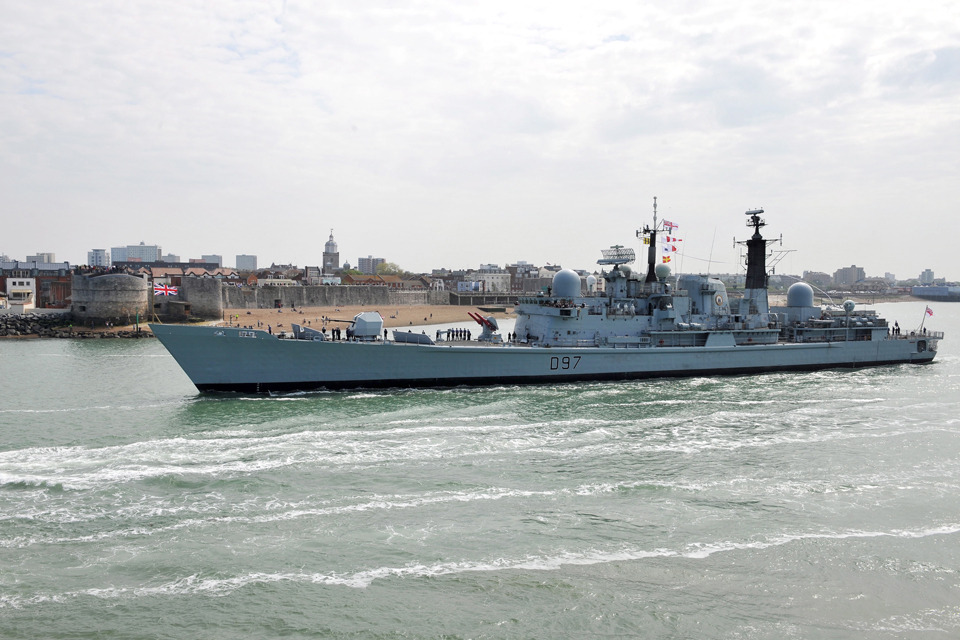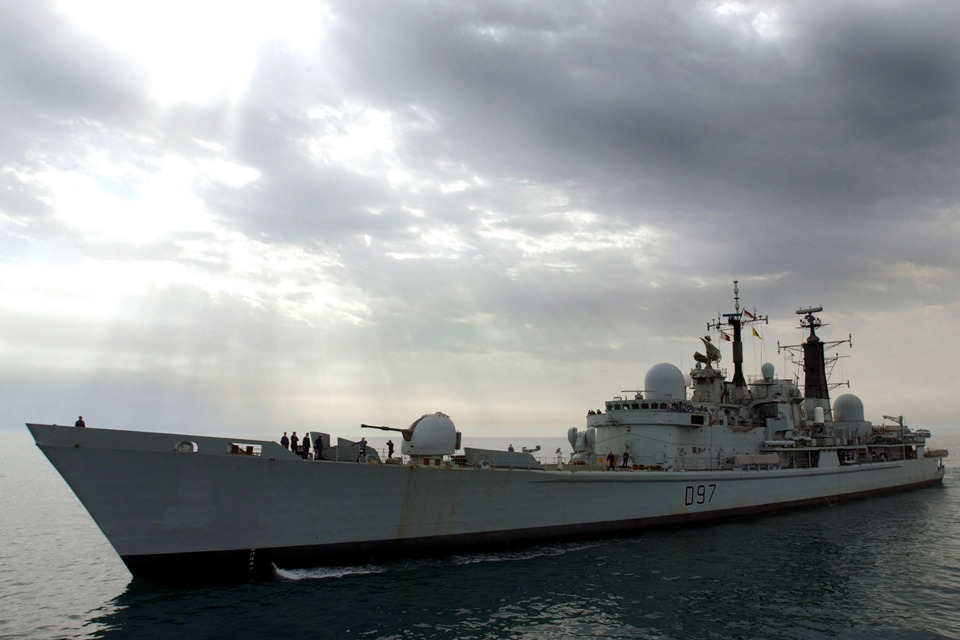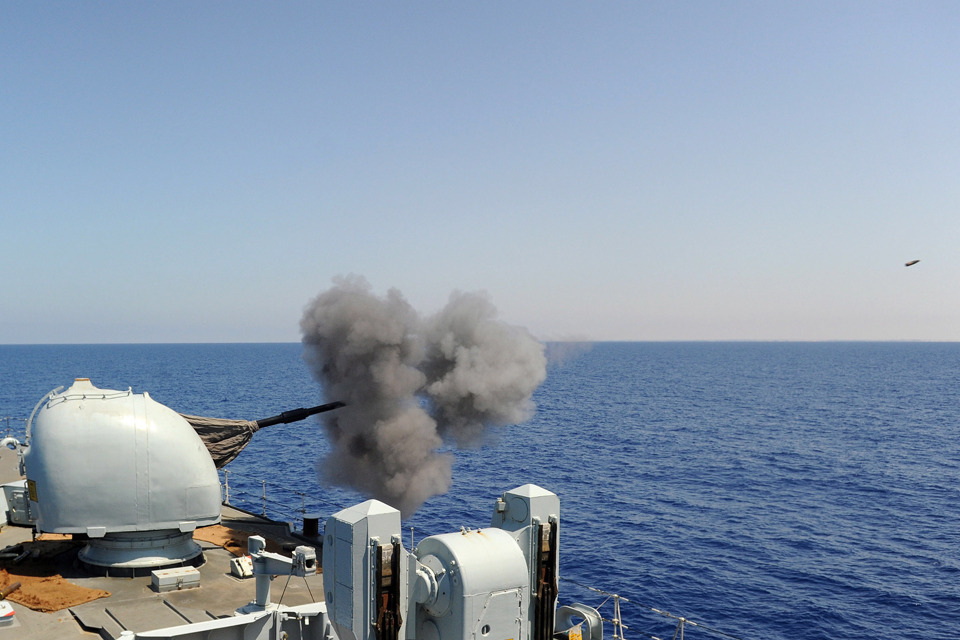Last Type 42 warship decommissions
HMS Edinburgh, the last of the Royal Navy's Type 42 destroyers, officially bows out of service today, Thursday 6 June.

HMS Edinburgh's port side smokes after firing a 21-gun salute on her final entry into Portsmouth – Type 45 destroyer HMS Defender follows in her wake [Picture: Leading Airman (Photographer) Guy Pool, Crown copyright]
HMS Edinburgh’s White Ensign will be lowered for the last time during her decommissioning ceremony at Portsmouth Naval Base, ending an era which began with the launch of HMS Sheffield in 1971.
The ageing Type 42s, which have served the Navy across the globe for 40 years, have gradually been phased out to make way for the Type 45s, which are among the most sophisticated and powerful warships in the world.
Among hundreds of guests at the decommissioning ceremony today will be Lady Heseltine, HMS Edinburgh’s sponsor, and wife of former Defence Secretary Michael Heseltine, who launched the ship on 14 April 1983.
Seventeen of the ship’s former commanding officers and dozens of Type 42 veterans will also attend.

HMS Edinburgh passes the Round Tower on her final entry into Portsmouth [Picture: Leading Airman (Photographer) Guy Pool, Crown copyright]
Edinburgh’s 270-strong ship’s company will be on parade during the 50-minute ceremony and will be inspected by Lady Heseltine and senior naval officers.
RAF Typhoon and Hawk aircraft, together with a Sea Fury from the Royal Navy Historic Flight, will perform a flypast before the final lowering of the White Ensign.
HMS Edinburgh’s Commanding Officer, Commander Nick Borbone, said:
It will be a poignant day for all of us associated with HMS Edinburgh. It is also a day of celebration when we remember the 40 years of faithful service that ‘The Fighting 42s’ have given, manned by dedicated men and women, proud to serve in this world-renowned class of ship.
Career highlights

HMS Edinburgh on patrol in the Gulf during Operation Telic in 2003 (library image) [Picture: Colin Burden, Crown copyright]
Built by Cammell Laird at Birkenhead, Edinburgh was commissioned in December 1985; the 14th and final Type 42 to enter service.
Her first deployment was to the Gulf in 1987, escorting numerous merchant ships safely through the region.
The following year His Royal Highness The Duke of York joined as one of the ship’s officers, serving on board during a 6-month round-the-world deployment.
In 1996, Edinburgh rescued the crew of a crippled sailing boat while on patrol in the Gulf. She despatched her Lynx helicopter to rescue all 9 Pakistani crewmen from the vessel after it took on water in stormy conditions and eventually sank.
She took part in the second Gulf War in 2003, supporting Royal Marines ashore and acting as escort to the helicopter carrier HMS Ocean.
The following year Edinburgh deployed to the Mediterranean and was involved in Operation Active Endeavour, monitoring sea lanes as part of the war on terror.
And in 2008, during operations in the Gulf, she seized a drugs cargo – stashed on board a sailing boat – worth several million pounds.
Edinburgh entered refit in 2010 and spent most of the following year in the South Atlantic. She returned from her final deployment – conducting security patrols across the South and North Atlantic – in March.
The end of an era

HMS Liverpool fires her 4.5-inch gun during operations off Libya (library image) [Picture: Leading Airman (Photographer) Caz Davies, Crown copyright]
Type 42 air defence destroyers have been the backbone of the Royal Navy’s fleet since the first – HMS Sheffield – was commissioned in 1975.
They have served on operations across the globe, including the Falklands conflict of 1982 and the Gulf War in 1991. As recently as 2011, HMS Liverpool was ordered to Libya as part of the Navy’s contribution to NATO’s naval blockade of the country during its civil war.
Liverpool supported the no-fly zone by controlling NATO aircraft from the sea, enforced the embargo on arms sales to the Gaddafi regime, and fired 111 high-explosive rounds against targets ashore.
Type 45 takes the baton

Type 45 air defence destroyer HMS Daring (library image) [Picture: Leading Airman (Photographer) Gary Weatherston, Crown copyright]
The Type 42s have been replaced by the Type 45 destroyers; the most advanced warships the nation has ever built. Several of the new class of ship have already deployed operationally to the Middle East and across the Atlantic.
Their mission is to shield the fleet from air attack using the Sea Viper missile system which can knock targets out of the sky up to 70 miles away if necessary.
The Type 45s can also be used as general-purpose warships; they have huge flight decks to accommodate helicopters up to the size of a Chinook. There’s also enough space on board to host a Royal Marines detachment up to 60-men strong.
As for the ship’s company, they enjoy ‘creature comforts’ only dreamed of by their forebears; no sailor lives in a mess square for more than 6 people and there are no communal heads (toilets) or showers.
All Type 45s are based in Portsmouth and will serve until around 2040.